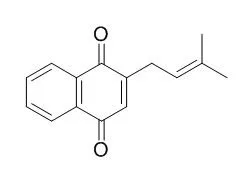| In vitro: |
| Planta Med. 2006 Aug;72(10):943-4. | | Activity of quinones from teak (Tectona grandis) on fungal cell wall stress.[Pubmed: 16972200] |
METHODS AND RESULTS:
Teak ( Tectona grandis L.f., Verbenaceae) sawdust extract inhibited the growth of Aspergillus niger. Centrifugal partition chromatography was used to isolate the active compounds. By (1)H-NMR the active compounds were identified as Deoxylapachol and tectoquinone. Two A. niger transgenic strains which show induction of 1,3 -alpha-D-glucan synthase were used as a cell wall damage model.
CONCLUSIONS:
The result showed that Deoxylapachol from T. grandis extract induced fungal cell wall stress. | | J. Wood Chem.Technol.,2008, 28(4):247- 60. | | Identification of Anti-Wood Rot Compounds in Teak (Tectona grandis L.f.) Sawdust Extract.[Reference: WebLink] |
METHODS AND RESULTS:
The tropical hardwood sawdust of Tectona grandis L.f. from the wood processing industry was extracted and tested for anti-wood rot activity. Tectona grandis extract inhibited the brown rot fungi Gloeophyllum sepiarium, Gloeophyllum trabeum, Piptoporus betulinus and Serpula lacrymans, and the white rot fungi Bjerkandera adusta, Merulius tremellosus, and Phlebia brevispora. Centrifugal partition chromatography was used to separate these compounds using n-hexane-MeOH-H2O (50:47.5:2.5) as a solvent system. The compounds Deoxylapachol, tectoquinone, 2-hydroxymethylanthraquinone, 3′-OH-deoxyisolapachol (2-[(1E)-3-hydroxy-3-methylbut-1-enyl]naphthoquinone), hemitectol (2,2-dimethyl-2H-benzo[h]chromen-6-ol), and tectol were isolated from Tectona grandis sawdust CHCl3-MeOH (1:1) extract.
CONCLUSIONS:
Deoxylapachol inhibited the brown rot fungi Gloeophyllum sepiarium CBS 353.74 and Gloeophyllum trabeum CBS 318.50 and the white rot fungi Merulius tremellosus CBS 280.73 and Phlebia brevispora CBS 509.92. Hemitectol together with tectol showed a high percentage of cellulase inhibition followed by 3′-OH-deoxyisolapachol and Deoxylapachol. |
|






 Cell. 2018 Jan 11;172(1-2):249-261.e12. doi: 10.1016/j.cell.2017.12.019.IF=36.216(2019)
Cell. 2018 Jan 11;172(1-2):249-261.e12. doi: 10.1016/j.cell.2017.12.019.IF=36.216(2019) Cell Metab. 2020 Mar 3;31(3):534-548.e5. doi: 10.1016/j.cmet.2020.01.002.IF=22.415(2019)
Cell Metab. 2020 Mar 3;31(3):534-548.e5. doi: 10.1016/j.cmet.2020.01.002.IF=22.415(2019) Mol Cell. 2017 Nov 16;68(4):673-685.e6. doi: 10.1016/j.molcel.2017.10.022.IF=14.548(2019)
Mol Cell. 2017 Nov 16;68(4):673-685.e6. doi: 10.1016/j.molcel.2017.10.022.IF=14.548(2019)